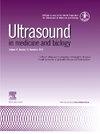A Practical CEUS TI-RADS Refer to Score and Grading of ACR TI-RADS (2017) for Thyroid Nodules
IF 2.6
3区 医学
Q2 ACOUSTICS
引用次数: 0
Abstract
Objective
To construct a contrast-enhanced ultrasound thyroid imaging reporting and data system (CEUS TI-RADS) based on ACR TI-RADS (2017) without changing the initial scores of conventional ultrasound features and reduce unnecessary fine-needle aspiration (FNA) of thyroid nodules.
Methods
This retrospective study involved patients with thyroid nodules who underwent conventional ultrasound, CEUS, and FNA from October 2020 to June 2024 in three hospitals. Univariable and multivariable logistic regression analysis was employed to filter out useful CEUS features. A CEUS TI-RADS was constructed to differentiate thyroid nodules between benign and malignant and indicate the necessity of FNA.
Results
A total of 1275 patients with 1521 thyroid nodules were recruited in this study. Arterial phase intensity, wash-out speed, ring enhancement, and enhancement direction (P-value all<0.001) were independent risk factors for malignant nodules in the training cohort. CEUS TI-RADS outperformed in diagnostic efficacy compared to ACR TI-RADS (AUC[CEUS] =0.94, 0.94, 0.92 vs AUC[ACR]=0.92, 0.91, 0.80 in training, internal validation and external validation cohort respectively, P-value all<0.001). CEUS TI-RADS could achieve a lower unnecessary biopsy rate (UBR) of 43% (81 of 190 nodules) in the training cohort, compared with 59% (156 of 264 nodules) of UBR in ACR TI-RADS. Similar results were confirmed concerning the validation cohorts.
Conclusion
The CEUS TI-RADS based on ACR TI-RADS (2017) without changing the initial scoring system of conventional ultrasound, was simple and effective in the differential diagnosis of thyroid nodules, which could reduce the unnecessary FNA rate of thyroid nodules than ACR TI-RADS.
实用的CEUS TI-RADS参考ACR TI-RADS(2017)对甲状腺结节的评分和分级。
目的:在不改变常规超声特征初始评分的情况下,在ACR TI-RADS(2017)基础上构建造影增强甲状腺超声影像报告与数据系统(CEUS TI-RADS),减少甲状腺结节的不必要细针穿刺(FNA)。方法:本回顾性研究纳入了2020年10月至2024年6月在三家医院接受常规超声、超声造影和FNA检查的甲状腺结节患者。采用单变量和多变量逻辑回归分析,过滤出有用的CEUS特征。构建超声造影(CEUS) TI-RADS鉴别甲状腺结节良恶性,提示FNA的必要性。结果:本研究共纳入1275例甲状腺结节1521例。在训练、内部验证和外部验证队列中,动脉期强度、洗脱速度、环形增强和增强方向(p值all[CEUS] =0.94、0.94、0.92 vs AUC[ACR]=0.92、0.91、0.80),p值all。基于ACR TI-RADS(2017)的CEUS TI-RADS在不改变常规超声初始评分制度的情况下,对甲状腺结节的鉴别诊断简单有效,与ACR TI-RADS相比,可减少甲状腺结节的不必要FNA率。
本文章由计算机程序翻译,如有差异,请以英文原文为准。
求助全文
约1分钟内获得全文
求助全文
来源期刊
CiteScore
6.20
自引率
6.90%
发文量
325
审稿时长
70 days
期刊介绍:
Ultrasound in Medicine and Biology is the official journal of the World Federation for Ultrasound in Medicine and Biology. The journal publishes original contributions that demonstrate a novel application of an existing ultrasound technology in clinical diagnostic, interventional and therapeutic applications, new and improved clinical techniques, the physics, engineering and technology of ultrasound in medicine and biology, and the interactions between ultrasound and biological systems, including bioeffects. Papers that simply utilize standard diagnostic ultrasound as a measuring tool will be considered out of scope. Extended critical reviews of subjects of contemporary interest in the field are also published, in addition to occasional editorial articles, clinical and technical notes, book reviews, letters to the editor and a calendar of forthcoming meetings. It is the aim of the journal fully to meet the information and publication requirements of the clinicians, scientists, engineers and other professionals who constitute the biomedical ultrasonic community.

 求助内容:
求助内容: 应助结果提醒方式:
应助结果提醒方式:


